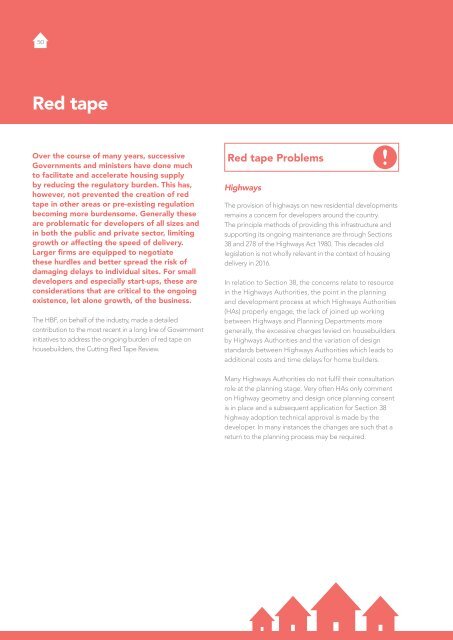Reversing the decline of small housebuilders
HBF_SME_Report_2017_Web
HBF_SME_Report_2017_Web
Create successful ePaper yourself
Turn your PDF publications into a flip-book with our unique Google optimized e-Paper software.
50<br />
Red tape<br />
Over <strong>the</strong> course <strong>of</strong> many years, successive<br />
Governments and ministers have done much<br />
to facilitate and accelerate housing supply<br />
by reducing <strong>the</strong> regulatory burden. This has,<br />
however, not prevented <strong>the</strong> creation <strong>of</strong> red<br />
tape in o<strong>the</strong>r areas or pre-existing regulation<br />
becoming more burdensome. Generally <strong>the</strong>se<br />
are problematic for developers <strong>of</strong> all sizes and<br />
in both <strong>the</strong> public and private sector, limiting<br />
growth or affecting <strong>the</strong> speed <strong>of</strong> delivery.<br />
Larger firms are equipped to negotiate<br />
<strong>the</strong>se hurdles and better spread <strong>the</strong> risk <strong>of</strong><br />
damaging delays to individual sites. For <strong>small</strong><br />
developers and especially start-ups, <strong>the</strong>se are<br />
considerations that are critical to <strong>the</strong> ongoing<br />
existence, let alone growth, <strong>of</strong> <strong>the</strong> business.<br />
The HBF, on behalf <strong>of</strong> <strong>the</strong> industry, made a detailed<br />
contribution to <strong>the</strong> most recent in a long line <strong>of</strong> Government<br />
initiatives to address <strong>the</strong> ongoing burden <strong>of</strong> red tape on<br />
<strong>housebuilders</strong>, <strong>the</strong> Cutting Red Tape Review.<br />
Red tape Problems<br />
Highways<br />
The provision <strong>of</strong> highways on new residential developments<br />
remains a concern for developers around <strong>the</strong> country.<br />
The principle methods <strong>of</strong> providing this infrastructure and<br />
supporting its ongoing maintenance are through Sections<br />
38 and 278 <strong>of</strong> <strong>the</strong> Highways Act 1980. This decades old<br />
legislation is not wholly relevant in <strong>the</strong> context <strong>of</strong> housing<br />
delivery in 2016.<br />
In relation to Section 38, <strong>the</strong> concerns relate to resource<br />
in <strong>the</strong> Highways Authorities, <strong>the</strong> point in <strong>the</strong> planning<br />
and development process at which Highways Authorities<br />
(HAs) properly engage, <strong>the</strong> lack <strong>of</strong> joined up working<br />
between Highways and Planning Departments more<br />
generally, <strong>the</strong> excessive charges levied on <strong>housebuilders</strong><br />
by Highways Authorities and <strong>the</strong> variation <strong>of</strong> design<br />
standards between Highways Authorities which leads to<br />
additional costs and time delays for home builders.<br />
Many Highways Authorities do not fulfil <strong>the</strong>ir consultation<br />
role at <strong>the</strong> planning stage. Very <strong>of</strong>ten HAs only comment<br />
on Highway geometry and design once planning consent<br />
is in place and a subsequent application for Section 38<br />
highway adoption technical approval is made by <strong>the</strong><br />
developer. In many instances <strong>the</strong> changes are such that a<br />
return to <strong>the</strong> planning process may be required.


